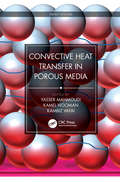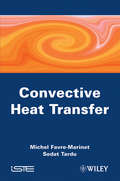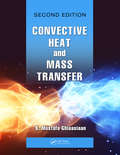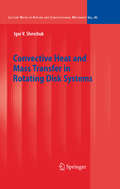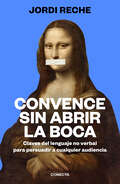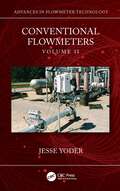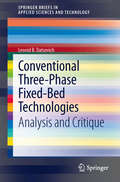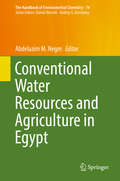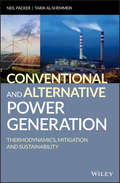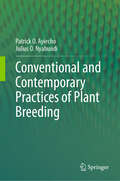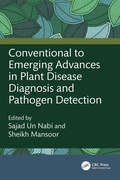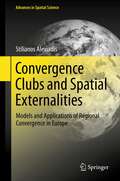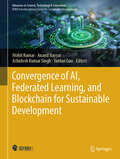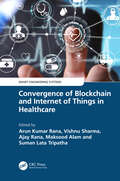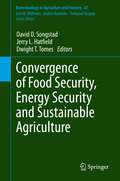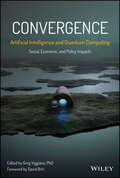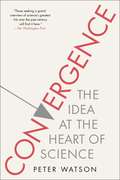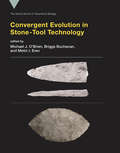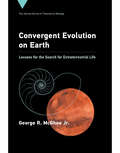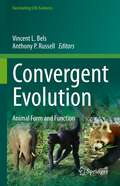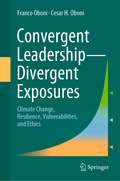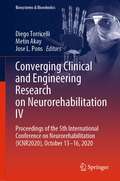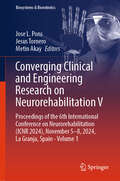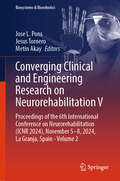- Table View
- List View
Convective Heat Transfer in Porous Media (Energy Systems)
by Kambiz Vafai Yasser Mahmoudi Kamel HoomanFocusing on heat transfer in porous media, this book covers recent advances in nano and macro’ scales. Apart from introducing heat flux bifurcation and splitting within porous media, it highlights two-phase flow, nanofluids, wicking, and convection in bi-disperse porous media. New methods in modeling heat and transport in porous media, such as pore-scale analysis and Lattice–Boltzmann methods, are introduced. The book covers related engineering applications, such as enhanced geothermal systems, porous burners, solar systems, transpiration cooling in aerospace, heat transfer enhancement and electronic cooling, drying and soil evaporation, foam heat exchangers, and polymer-electrolyte fuel cells.
Convective Heat Transfer: Solved Problems
by Sedat Tardu Michel Favre-MarinetEach chapter begins with a brief yet complete presentation of the related topic. This is followed by a series of solved problems. The latter are scrupulously detailed and complete the synthetic presentation given at the beginning of each chapter. There are about 50 solved problems, which are mostly original with gradual degree of complexity including those related to recent findings in convective heat transfer phenomena. Each problem is associated with clear indications to help the reader to handle independently the solution. The book contains nine chapters including laminar external and internal flows, convective heat transfer in laminar wake flows, natural convection in confined and no-confined laminar flows, turbulent internal flows, turbulent boundary layers, and free shear flows.
Convective Heat and Mass Transfer
by S. Mostafa GhiaasiaanThis book was developed during Professor Ghiaasiaan's ten years of teaching a graduate-level course on convection heat and mass transfer and is further enhanced by his twenty years of teaching experience. Ideal for a graduate course dealing with the theory and practice of convection heat and mass transfer, it treats well-established theory and practice, but is also enriched by its coverage of modern areas such as flow in microchannels and computational fluid dynamics-based design and analysis methods. Convection heat transfer is the main focus, and essentials of mass transfer are also covered. The mass transfer material and problems are presented such that they can be easily skipped. The book is richly enhanced by examples and end-of-chapter exercises with solutions available for qualified instructors. It includes 18 appendices providing compilations of most essential property and mathematical information for analysis of convective heat and mass transfer processes.
Convective Heat and Mass Transfer (Heat Transfer)
by S. Mostafa GhiaasiaanConvective Heat and Mass Transfer, Second Edition, is ideal for the graduate level study of convection heat and mass transfer, with coverage of well-established theory and practice as well as trending topics, such as nanoscale heat transfer and CFD. It is appropriate for both Mechanical and Chemical Engineering courses/modules.
Convective Heat and Mass Transfer in Rotating Disk Systems (Lecture Notes in Applied and Computational Mechanics #45)
by Igor V. ShevchukThe book describes results of investigations of a series of convective heat and mass transfer problems in rotating-disk systems, namely, over free rotating disks, under conditions of transient heat transfer, solid- body rotation of fluid, orthogonal flow impingement onto a disk, swirl radial flow between parallel co-rotating disks, in cone-disk systems and for Prandtl and Schmidt numbers larger than unity. Methodology used included integral methods, self-similar and approximate analytical solutions, as well as CFD. The book is aimed at the professional audience of academic researchers, industrial R&D engineers, university lecturers and graduate/postgraduate students working in the area of rotating-disk systems.
Convence sin abrir la boca: Claves del lenguaje no verbal para persuadir a cualquier audiencia
by Jordi RecheDescubre las claves del lenguaje no verbal para cautivar y persuadir a cualquier audiencia y en cualquier situación. En el entorno personal y profesional, nuestros gestos, miradas, posturas, sonrisas... dicen más de nosotros que las palabras que pronunciamos. Porque el lenguaje del cuerpo es revelador: cómo nos sentamos, cómo caminamos, cómo saludamos..., todo comunica. Los demás interpretan y recuerdan nuestros mensajes por lo que transmitimos a nivel visual mucho más que por lo que decimos. Pero ¿sabes qué expresas con tu cuerpo? Jordi Reche te descubre los secretos del lenguaje no verbal: qué significa cada gesto, por qué lo haces y cómo interpretarlo tanto en ti mismo como en los demás. Convence sin abrir la boca te proporciona las herramientas para dominar el lenguaje corporal y conectar con tus interlocutores. Aprende a utilizarlas para ser más convincente y persuasivo, transmitir mayor seguridad y confianza, y ganar influencia entre quienes te rodean. En este libro aprenderás: * A comunicar mejor, reforzando tu mensaje hablado con tu gestualidad. * A tener mayor consciencia de tu cuerpo y a utilizarlo para sentirte mejor y para que, quienes te rodean, te vean mejor. * A leer en los gestos de los demás información que han decidido no darte u ocultarte, o simplemente a descifrar que te están mintiendo.* A descubrir que tu poder de persuasión puede aumentar de manera significativa si cuidas tu lenguaje no verbal de líder. * A conocer mejor los mensajes que envían tus fotos de perfil, tus fotos grupales o los vídeos que cuelgas en las redes. * A detectar las emociones reales de una persona, más allá de lo que nos cuente con sus palabras. * A aumentar tu capacidad de seducción y a leer en el cuerpo de las personas con las que te relacionas si estás atrayendo su atención de manera positiva o no. Reseñas:«Con el libro de Jordi puedes aprender tanto a leer a los demás como a mejorar tu comunicación de una forma amena y entretenida. Puedes usarlo siempre que quieras para mejorar y llevar tu comunicación y conocimiento a otro nivel que no muchos conocen».Jose Fernández @soycriminologo. Experto en criminología y comportamiento no verbal«Jordi ha condensado en un libro una gran cantidad de trucos y técnicas para entender cómo funciona la comunicación no verbal. Esto permite que lo apliques es muchos ámbitos: en negociaciones, ventas, formaciones... Es un manual didáctico y directo que te ayudará a iniciarte de lleno en el apasionante mundo de la comunicación».Fernando Miralles. Formador y divulgador experto en oratoria«Jordi te explica paso a paso todo lo que cualquier comunicador debería saber, ya sea hablando con un cliente o frente a miles de espectadores. Sin duda, una caja de herramientas que todo profesional debería leer. Un título obligatorio para cualquiera que desee destacarse en su carrera».Nico Fernández Miranda. Empresario, conferencista y profesor universitario«En este mundo tan expeditivo Jordi nos enseña no solo cómo mejorar nuestro lenguaje corporal sino también cómo leer a quienes tenemos enfrente, esto nos ayudara luego a complementar nuestro objetivo final en una reunión o quizás en esa charla incomoda que tanto evadimos. Aquí aprenderás cómo congeniar eso que quieres decir no solo con palabras si no con todo tu cuerpo».Evelina Cabrera. Entrenadora de fútbol, coach deportivo y escritora
Conventional Flowmeters: Volume II
by Jesse YoderConventional Flowmeters covers origin, principle of operation, development, advantages and disadvantages, applications, and frontiers of research for conventional technology flowmeters, which include differential pressure and primary elements, positive displacement, turbine, open channel, and variable area. There are more conventional technology meters being used in the field than new-technology meters. New developments, such as more accurate pressure transmitters, new primary elements such as cone elements, reversible flow, and dual rotor turbine meters, and variable area meters with transmitters and a signal output, are discussed. Features: Offers a working knowledge of the origin and development of the more traditional technology flowmeters: differential pressure and primary elements, positive displacement, turbine, open channel, and variable area Describes how these conventional meters still fit into what is being called Industry 4.0 Discusses the advantages and disadvantages of conventional technology meters and provides a rationale for retaining or replacing these meters Focuses on the origin, development operating principles, and applications for the meters Explores the development of each conventional flowmeter type, including the roles of companies such as Siemens, ABB, Emerson, Foxboro, KROHNE, and Endress+Hauser This book is designed for anyone involved with flowmeters and instrumentation, including product and marketing managers, strategic planners, application engineers, and distributors.
Conventional Three-Phase Fixed-Bed Technologies: Analysis and Critique (SpringerBriefs in Applied Sciences and Technology #7)
by Leonid B. DatsevichThis book analyzes conventional fixed-bed reactors such as trickle-bed, bubble (packed) column, and multitubular reactors with regard to process efficiency, design and safety. It is shown that these reactors do not possess any substantial potential for improving industrial processes. Modern concepts in mass transfer, kinetics and process design are applied to process development. In light of the given analysis, new approaches to the development of technologies based on innovative principles are elucidated. For the first time, first-hand knowledge about Two-Zone Model, Oscillation Theory, map of the energy dissipation is presented in full.
Conventional Water Resources and Agriculture in Egypt (The Handbook of Environmental Chemistry #74)
by Abdelazim M. NegmThis unique volume focuses on Egypt’s conventional water resources and the main water consumer: Egypt’s agriculture. It provides an up-to-date overview and the latest research findings, and covers the following main topics: · History of irrigation and irrigation projects · Key features of agriculture, the administrative and legal framework in Egypt · Land resources for agriculture development · Food insecurity due to water shortages and climate change; resulting challenges and opportunities · Assessment of water resources for irrigation and drinking purposes · Impacts of upstream dams, such as the GERD and Tekeze Dam, on Egypt’s water resources and crop yield · Sustainable use of water resources and the future of mega irrigation projects · Quantity and quality of water in Egypt’s water resources bank This book and the companion volume Unconventional Water Resources and Agriculture in Egypt offer invaluable reference guides for postgraduates, researchers, professionals, environmental managers and policymakers interested in water resources and their management worldwide.
Conventional and Alternative Power Generation: Thermodynamics, Mitigation and Sustainability
by Tarik Al-Shemmeri Neil PackerA much-needed, up-to-date guide on conventional and alternative power generation This book goes beyond the traditional methods of power generation. It introduces the many recent innovations on the production of electricity and the way they play a major role in combating global warming and improving the efficiency of generation. It contains a strong analytical approach to underpin the theory of power plants—for those using conventional fuels, as well as those using renewable fuels—and looks at the problems from a unique environmental engineering perspective. The book also includes numerous worked examples and case studies to demonstrate the working principles of these systems. Conventional and Alternative Power Generation: Thermodynamics, Mitigation and Sustainability is divided into 8 chapters that comprehensively cover: thermodynamic systems; vapor power cycles, gas power cycles, combustion; control of particulates; carbon capture and storage; air pollution dispersal; and renewable energy and power plants. Features an abundance of worked examples and tutorials Examines the problems of generating power from an environmental engineering perspective Includes all of the latest information, technology, theories, and principles on power generation Conventional and Alternative Power Generation: Thermodynamics, Mitigation and Sustainability is an ideal text for courses on mechanical, chemical, and electrical engineering.
Conventional and Contemporary Practices of Plant Breeding
by Patrick O. Ayiecho Julius O. NyabundiThis book covers some established conventional and recent advances in plant breeding methods. It highlights and treats in detail some breeding strategies not adequately handled or usually ignored in many plant breeding texts. There is in-depth coverage of plant resistance mechanisms to various stress factors and application of phenotyping, genotyping, bioinformatics, molecular markers, ‘omics’ technologies, biotechnology, transgenesis and gene editing in crop improvement. Topics like germplasm conservation, plant sex expression and pollination control, recurrent selection methods, interspecific hybridisation, pre-breeding, chromosome manipulation and breeding for resistance to diseases and insect pests are comprehensively covered. The book gives special attention to some problems that affect food security in developing countries, e.g., parasitic weeds and drought and heat stress. Breeding for resistance to parasitic weeds like Striga, broomrapes and Cascuta is always ignored in most plant breeding texts. Where applicable, problems and challenges associated with some breeding strategies are highlighted and possible solutions proposed. The text is rich in relevant examples for various topics. The book is suitable for teaching of plant breeding at the university level and is also beneficial to practising plant breeders. It brings together some relevant work and literary information that is useful to university lecturers, students and practising plant breeders. The book targets university students in agricultural and plant sciences, particularly those taking plant breeding as a key unit/course.
Conventional to Emerging Advances in Plant Disease Diagnosis and Pathogen Detection
by Sheikh Mansoor Sajad Un NabiDiseases in crops cause significant economic losses by decreasing both the yield and quality of produce. Early and accurate diagnosis of these diseases is crucial, as it enhances the effectiveness of management strategies and helps prevent long-term damage to infected plants. The need for precise, swift, and efficient methods for diagnosing diseases and detecting pathogens remains a top priority. Conventional to Emerging Advances in Plant Disease Diagnosis and Pathogen Detection comprehensively addresses key diagnostic methods and pathogen detection techniques, from their origins to the present, guiding us toward the future of plant diagnostics. It serves as a valuable resource for academics, extension workers, and growers, offering the latest information on developments in disease diagnosis and pathogen detection.The chapters within this volume offer a comprehensive journey through the historical perspectives and groundbreaking innovations that have shaped disease diagnosis. We traverse the conventional methods that have laid the foundation for our understanding, and then embark on a journey through emerging technologies that promise to revolutionize the field. This compilation aims to connect traditional knowledge with the latest technological advancements, offering a comprehensive view of the trajectory of plant disease diagnosis. Created through collaborative efforts of field experts sharing insights and experiences, this resource is not only informative but also forward-thinking. Features Comprehensive coverage of both traditional and contemporary diagnostic techniques for identifying plant diseases and detecting pathogens. Detailed exploration of the latest advancements and innovations in disease diagnosis and pathogen detection, providing up-to-date knowledge. In-depth discussion of cutting-edge diagnostic strategies, including artificial intelligence, machine learning, biosensors, next-generation sequencing, point-of-care assays, and CRISPR-Cas systems. Abundantly illustrated with diagrams, flowcharts, and representations to support field identification and precise diagnosis of plant diseases.
Convergence Clubs and Spatial Externalities: Models and Applications of Regional Convergence in Europe (Advances in Spatial Science)
by Stilianos AlexiadisDo dynamic externalities, in the form of technology creation, adoption and spatial agglomeration shape the pattern of regional growth in Europe? This study provides an alternative view on regional convergence. A model is developed which attributes club-convergence to existing differences with respect to the degree of technology adoption. In the first instance, empirical results suggest that the NUTS-2 regions of the EU-27 converge at a very slow rate. Further tests, however, indicate that convergence is restricted to a specific subset of regions. Such conclusions are tested further, using an alternative model of club-convergence, which incorporates the impact of spatial interaction, agglomeration externalities and technology. This shows that the convergence-club in Europe follows a certain geographical pattern and all members share similar characteristics regarding technology creation and adoption, and agglomeration externalities.
Convergence of AI, Federated Learning, and Blockchain for Sustainable Development (Advances in Science, Technology & Innovation)
by Ashutosh Kumar Singh Anand Nayyar Mohit Kumar Yanhui GuoThis book provides current state of the art along with an insight of recent research trends and open issues, challenges, and future research direction for the academician, analyzer, researcher, writers, and authors. It also provides an opportunity to exchange knowledge in the field of IoT-enabled smart systems, Industry 4.0, networking, cyber-physical system, computing paradigms, and security with various tools and methods used for industry-oriented intelligent-based IoT applications. This advanced research edited book focuses on emerging and advancing technology-federated machine learning, blockchain, and artificial intelligence for real-time Internet of things (IoT) application to solve the real-world problems and make the life of human more conformable. The objective of the proposed book is to develop privacy preserving model for IoT applications and improve the security, privacy, reliability, and sustainability of the systems. This book motivates and enhances the quality of research and commercialization in the fields of AI, Industry 4.0, federated learning, and blockchain.
Convergence of Blockchain and Internet of Things in Healthcare (Smart Engineering Systems: Design and Applications)
by Arun Kumar Rana, Vishnu Sharma, Ajay Rana, Maksud Alam and Suman Lata TripathiThe Internet of Things (IoT) and blockchain are two new technologies that combine elements in many ways. A system where the virtual and physical worlds interact is created by integrating pervasive computing, ubiquitous computing, communication technologies, sensing technologies, Internet Protocol, and embedded devices. A massive number of linked devices and vast amounts of data present new prospects for developing services that can directly benefit the economy, environment, society, and individual residents. Due to the size of IoT and insufficient data security, security breaches may have a huge impact and negative effects. IoT not only connects gadgets but also people and other entities, leaving every IoT component open to a wide variety of assaults. The implementation and application of IoT and blockchain technology in actual scientific, biomedical, and data applications are covered in this book. The book highlights important advancements in health science research and development by applying the distinctive capabilities inherent to distributed ledger systems. Each chapter describes the current uses of blockchain in real-world data collection, medicine development, device tracking, and more meaningful patient interaction. All of these are used to create opportunities for expanding health science research. This paradigm change is studied from the perspectives of pharmaceutical executives, biotechnology entrepreneurs, regulatory bodies, ethical review boards, and blockchain developers.Key Features: Provides a foundation for the implementation process of blockchain and IoT devices based on healthcare-related technology Image processing and IoT device researchers can correlate their work with other requirements of advanced technology in the healthcare domain Conveys the latest technology, including artificial intelligence and machine learning, in healthcare-related technology Useful for the researcher to explore new things like security, cryptography, and privacy in healthcare related technology Tailored for people who want to start in healthcare-related technology with blockchain and IoT This book is primarily for senior undergraduates, graduate students, and academic researchers in the fields of electrical engineering, electronics and communication engineering, computer science and engineering, and biomedical engineering.
Convergence of Food Security, Energy Security and Sustainable Agriculture (Biotechnology in Agriculture and Forestry #67)
by Jerry L. Hatfield David D. Songstad Dwight T. TomesThis volume examines the interrelated fields of food security, energy security and sustainable agriculture as the key to a stable global agricultural platform and is arranged in six parts The first part is focused on policy considerations relating to food and energy security and sustainable agriculture The authors from this part include Former Under Secretary of Agriculture Gale Buchanan, Former Under Secretary of Energy Raymond Orbach (Chapter 1), Stephen Hughes, Bryan Moser and William Gibbons (Chapter 2) and Thomas Redick (Chapter 3) Part II addresses soil and water, which are two of the key components in secure and sustainable food production Authors from this part are Jerry Hatfield (Chapter 4) and Mahbub Alam, Sharon Megdal et al. (Chapter 5) The third part covers sustainable and secure food production specifically addressing genetically modified traits in Chapter 6 (James McWilliams) and omega-3 fatty acids in Chapter 7 (Jay Whelan et al. ) Agronomic implications relative to food security and sustainable agriculture are described in Part IV Authors include Ravi Sripada, Pradip Das et al. (Chapter 8), Duska Stojsin, Kevin Matson and Richard Leitz (Chapter 9) and S. H. Lee, David Clay and Sharon Clay (Chapter 10) International sustainable agriculture and food security is addressed in Part V with authors Jeff Vitale and John Greenplate (Chapter 11), Julie Borlaug et al. (Chapter 12) and Sylvester Oikeh et al. (Chapter 13) The final part covers the use of chemicals in sustainable agriculture and food/energy security with Leonard Gianessi and Ashley Williams communicating the role of herbicides and Harold Reetz emphasizing the importance of fertilizers both in maximizing crop yields to maintain a sustainable secure source for food production.
Convergence: Social, Economic, and Policy Impacts
by Greg ViggianoPrepare for the coming convergence of AI and quantum computing A collection of essays from 20 renowned, international authors working in industry, academia, and government, Convergence: Artificial Intelligence and Quantum Computing explains the impending convergence of artificial intelligence and quantum computing. A diversity of viewpoints is presented, each offering their view of this coming watershed event. In the book, you&’ll discover that we&’re on the cusp of seeing the stuff of science fiction become reality, with huge implications for ripping up the existing social fabric, global economy, and current geopolitical order. Along with an incisive foreword by Hugo- and Nebula-award winning author David Brin, you&’ll also find: Explorations of the increasing pace of technological development Explanations of why seemingly unusual and surprising breakthroughs might be just around the corner Maps to navigate the potential minefields that await us as AI and quantum computing come togetherA fascinating and thought-provoking compilation of insights from some of the leading technological voices in the world, Convergence convincingly argues that we should prepare for a world in which very little will remain the same and shows us how to get ready.
Convergence: The Idea at the Heart of Science
by Peter WatsonA brilliant history of science over the past 150 years that offers a powerful new argument—that the many disparate scientific branches are converging on the same truths.Convergence is a history of modern science with an original and significant twist. Various scientific disciplines, despite their very different beginnings, have been coming together over the past 150 years, converging and coalescing. Intimate connections have been discovered between physics and chemistry, psychology and biology, genetics and linguistics. In this groundbreaking book, Peter Watson identifies one extraordinary master narrative, capturing how the sciences are slowly resolving into one overwhelming, interlocking story about the universe. Watson begins his narrative in the 1850s, the decade when, he argues, the convergence of the sciences began. The idea of the conservation of energy was introduced in this decade, as was Darwin’s theory of evolution—both of which rocketed the sciences forward and revealed unimagined interconnections and overlaps between disciplines. The story then proceeds from each major breakthrough and major scientist to the next, leaping between fields and linking them together. Decade after decade, the story captures every major scientific advance en route to the present, proceeding like a cosmic detective story, or the world’s most massive code-breaking effort. Watson’s is a thrilling new approach to the history of science, revealing how each piece falls into place, and how each uncovers an “emerging order.” Convergence is, as Nobel Prize-winning physicist Steven Weinberg has put it, “The deepest thing about the universe.” And Watson’s comprehensive and eye-opening book argues that all our scientific efforts are indeed approaching unity. Told through the eyes of the scientists themselves, charting each discovery and breakthrough, it is a gripping way to learn what we now know about the universe and where our inquiries are heading.
Convergent Evolution in Stone-Tool Technology (Vienna Series in Theoretical Biology #22)
by Michael O'Brien Briggs Buchanan Metin ErenScholars from a variety of disciplines consider cases of convergence in lithic technology, when functional or developmental constraints result in similar forms in independent lineages. Hominins began using stone tools at least 2.6 million years ago, perhaps even 3.4 million years ago. Given the nearly ubiquitous use of stone tools by humans and their ancestors, the study of lithic technology offers an important line of inquiry into questions of evolution and behavior. This book examines convergence in stone tool-making, cases in which functional or developmental constraints result in similar forms in independent lineages. Identifying examples of convergence, and distinguishing convergence from divergence, refutes hypotheses that suggest physical or cultural connection between far-flung prehistoric toolmakers. Employing phylogenetic analysis and stone-tool replication, the contributors show that similarity of tools can be caused by such common constraints as the fracture properties of stone or adaptive challenges rather than such unlikely phenomena as migration of toolmakers over an Arctic ice shelf.ContributorsR. Alexander Bentley, Briggs Buchanan, Marcelo Cardillo, Mathieu Charbonneau, Judith Charlin, Chris Clarkson, Loren G. Davis, Metin I. Eren, Peter Hiscock, Thomas A. Jennings, Steven L. Kuhn, Daniel E. Lieberman, George R. McGhee, Alex Mackay, Michael J. O'Brien, Charlotte D. Pevny, Ceri Shipton, Ashley M. Smallwood, Heather Smith, Jayne Wilkins, Samuel C. Willis, Nicolas Zayns
Convergent Evolution on Earth: Lessons for the Search for Extraterrestrial Life (Vienna Series in Theoretical Biology #24)
by George R. McGheeAn analysis of patterns of convergent evolution on Earth that suggests where we might look for similar convergent forms on other planets.Why does a sea lily look like a palm tree? And why is a sea lily called a “lily” when it is a marine animal and not a plant? Many marine animals bear a noticeable similarity in form to land-dwelling plants. And yet these marine animal forms evolved in the oceans first; land plants independently and convergently evolved similar forms much later in geologic time. In this book, George McGhee analyzes patterns of convergent evolution on Earth and argues that these patterns offer lessons for the search for life elsewhere in the universe.Our Earth is a water world; 71 percent of the earth's surface is covered by water. The fossil record shows that multicellular life on dry land is a new phenomenon; for the vast majority of the earth's history—3,500 million years of its 4,560 million years of existence—complex life existed only in the oceans. Explaining that convergent biological evolution occurs because of limited evolutionary pathways, McGhee examines examples of convergent evolution in forms of feeding, immobility and mobility, defense, and organ systems. McGhee suggests that the patterns of convergent evolution that we see in our own water world indicate the potential for similar convergent forms in other water worlds. We should search for extraterrestrial life on water worlds, and for technological life on water worlds with continental landmasses.
Convergent Evolution: Animal Form and Function (Fascinating Life Sciences)
by Vincent L. Bels Anthony P. RussellThis volume presents a series of case studies, at different levels of inclusivity, of how organisms exhibit functional convergence as a key evolutionary mechanism resulting in responses to similar environmental constraints in mechanically similar ways. The contributors to this volume have selected and documented cases of convergent evolution of form and function that are perceived to be driven by environmental abiotic and/or biotic challenges that fall within their areas of expertise. Collectively these chapters explore this phenomenon across a broad phylogenetic spectrum. The sequence of chapters follows the organizational principle of increasing phylogenetic inclusivity, rather than the clustering of chapters by perceived similarity of the phenotypic features or biomechanical challenges being considered. This is done to maintain focus on the evolutionary phenomenon that is the primary subject matter of the book, thereby providing a basis for discussion among the readership about what is necessary and sufficient to justify the recognition of functional convergence. All chapters stress the need for integrative approaches for the elucidation of both pattern and process as they relate to convergence at various taxonomic levels.
Convergent Leadership-Divergent Exposures: Climate Change, Resilience, Vulnerabilities, and Ethics
by Franco Oboni Cesar H. OboniThis book aims, through its chapters, at providing the knowledge to make competent decisions, convince peers or top management to take appropriate action, or beat out the competition for climate adaptation measures including adjustments for design and operations. Topics discussed include business-as-usual vs. divergence; the effects of public pressure on corporate, industrial and government decision making; techniques for gathering the proper information to assess risks and hazards; the importance determining risk tolerance thresholds; the difference between tolerable risks, intolerable ones that benefit from mitigation and those that require strategic shifts; why common practice approaches such as FMEA, and risk matrices are inadequate in today’s world and do not help ensure infrastructural and systemic resilience and sustainability.Case histories and three complete case studies that can be adapted to any industry or project walk the reader step by step from client request to recommendations and conditions of validity. The ultimate aim is to understand how to reduce risks to tolerable and societally acceptable levels while simultaneously creating sustainable and ethical systems.
Converging Clinical and Engineering Research on Neurorehabilitation IV: Proceedings of the 5th International Conference on Neurorehabilitation (ICNR2020), October 13–16, 2020 (Biosystems & Biorobotics #28)
by Metin Akay Diego Torricelli Jose L. PonsThe book reports on advanced topics in the areas of neurorehabilitation research and practice. It focuses on new methods for interfacing the human nervous system with electronic and mechatronic systems to restore or compensate impaired neural functions. Importantly, the book merges different perspectives, such as the clinical, neurophysiological, and bioengineering ones, to promote, feed and encourage collaborations between clinicians, neuroscientists and engineers. Based on the 2020 International Conference on Neurorehabilitation (ICNR 2020) held online on October 13-16, 2020, this book covers various aspects of neurorehabilitation research and practice, including new insights into biomechanics, brain physiology, neuroplasticity, and brain damages and diseases, as well as innovative methods and technologies for studying and/or recovering brain function, from data mining to interface technologies and neuroprosthetics. In this way, it offers a concise, yet comprehensive reference guide to neurosurgeons, rehabilitation physicians, neurologists, and bioengineers. Moreover, by highlighting current challenges in understanding brain diseases as well as in the available technologies and their implementation, the book is also expected to foster new collaborations between the different groups, thus stimulating new ideas and research directions.
Converging Clinical and Engineering Research on Neurorehabilitation V: Proceedings of the 6th International Conference on Neurorehabilitation (ICNR 2024), November 5–8, 2024, La Granja, Spain - Volume 1 (Biosystems & Biorobotics #31)
by Metin Akay Jose L. Pons Jesus TorneroThe book reports on advanced topics in the areas of neurorehabilitation research and practice. It focuses on new methods for interfacing the human nervous system with electronic and mechatronic systems to restore or compensate impaired neural functions. Importantly, the book merges different perspectives, such as the clinical, neurophysiological, and bioengineering ones, to promote, feed and encourage collaborations between clinicians, neuroscientists and engineers. Based on the 2024 International Conference on Neurorehabilitation (ICNR2024) held in La Granja, Spain on November 5-8, 2024, this book covers various aspects of neurorehabilitation research and practice, including new insights into biomechanics, brain physiology, neuroplasticity, and brain damages and diseases, as well as innovative methods and technologies for studying and/or recovering brain function, from data mining to interface technologies and neuroprosthetics. In this way, it offers a concise, yet comprehensive reference guide to neurosurgeons, rehabilitation physicians, neurologists, and bioengineers. Moreover, by highlighting current challenges in understanding brain diseases as well as in the available technologies and their implementation, the book is also expected to foster new collaborations between the different groups, thus stimulating new ideas and research directions.
Converging Clinical and Engineering Research on Neurorehabilitation V: Proceedings of the 6th International Conference on Neurorehabilitation (ICNR 2024), November 5–8, 2024, La Granja, Spain - Volume 2 (Biosystems & Biorobotics #32)
by Metin Akay Jose L. Pons Jesus TorneroThe book reports on advanced topics in the areas of neurorehabilitation research and practice. It focuses on new methods for interfacing the human nervous system with electronic and mechatronic systems to restore or compensate impaired neural functions. Importantly, the book merges different perspectives, such as the clinical, neurophysiological, and bioengineering ones, to promote, feed and encourage collaborations between clinicians, neuroscientists and engineers. Based on the 2024 International Conference on Neurorehabilitation (ICNR2024) held in La Granja, Spain on November 5-8, 2024, this book covers various aspects of neurorehabilitation research and practice, including new insights into biomechanics, brain physiology, neuroplasticity, and brain damages and diseases, as well as innovative methods and technologies for studying and/or recovering brain function, from data mining to interface technologies and neuroprosthetics. In this way, it offers a concise, yet comprehensive reference guide to neurosurgeons, rehabilitation physicians, neurologists, and bioengineers. Moreover, by highlighting current challenges in understanding brain diseases as well as in the available technologies and their implementation, the book is also expected to foster new collaborations between the different groups, thus stimulating new ideas and research directions.
